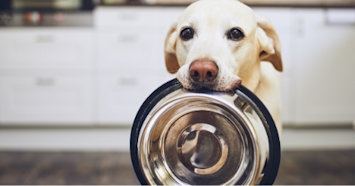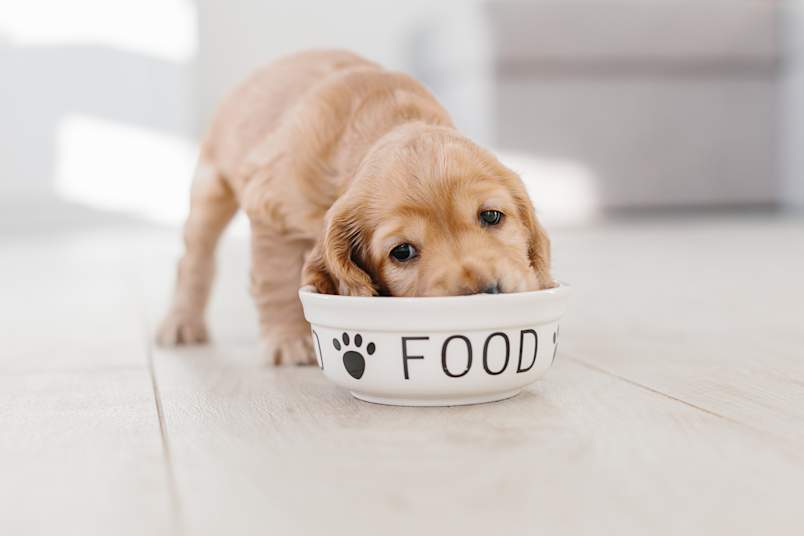
We all know those pleading eyes. Those big, brown pools that melt your heart and make you reach for "just one more" treat. But in the back of your mind, there's a question: how many calories should my dog eat? Can their diet affect a dog's life expectancy? It can be confusing to navigate all the charts and conflicting advice. The truth is, every dog is an individual, with unique energy needs based on their age, breed, and activity level. Determining the right number of calories for dogs can be challenging for pet owners. The amount of food a dog eats per day should be based on their ideal weight and the number of calories an average dog of that weight needs daily. Your veterinarian can perform an exam and assess your dog for his ideal, or healthy, weight.
Assessing Your Dog's Body Condition
If you want a general idea of whether your pet's weight is normal, you can use a body assessment.
A pet at a healthy weight should have ribs that are easy to feel but not too prominent.
If your dog's ribs feel like the tops of your knuckles when you make a fist, he may be too thin.
If the ribs feel like your knuckles when you flatten your palm, this indicates a healthy weight.
If you can barely feel the ribs, similar to the palm of your hand, he may be overweight.
Look for a visible waist when viewing your dog from above, with tapering from the ribs to the hips.
From the side, the belly should taper upwards, being less wide than the chest.
Every breed is different, so these measurements provide a general guideline. If your pet doesn't seem to be at a healthy weight, schedule a check-up with your vet to be sure. Calculating Your Dog's Daily Calorie Needs Assuming your dog is at a healthy weight and activity level, you can use this formula to estimate the calories (kilocalories or kcal) your dog needs per day. Calorie (kcal) needs = 1.6 [70 x (weight in pounds ÷ 2.2)0.75] A healthy, 10-pound dog with an average activity level will need roughly 350 calories a day to maintain their weight. This amount is only an estimate and should be based on the dog's individual needs:
Overweight dogs will need fewer calories
Very active dogs will need more calories
Pregnant or nursing dogs will require significantly more calories
Sick pets, such as those with cancer or kidney disease, may need more calories.
Calorie Requirements Based on Life Stage A dog's calorie needs vary depending on their life stage. Here's a general guide:
| Weight lbs | Puppy under 4 months | Puppy over 4 months | Adult neutered | Adult intact | Senior |
|---|---|---|---|---|---|
| 5 | 390 | 260 | 208 | 234 | 182 |
| 10 | 654 | 436 | 349 | 392 | 305 |
| 20 | 1098 | 732 | 586 | 659 | 512 |
| 30 | 1491 | 994 | 795 | 895 | 696 |
| 40 | 1848 | 1232 | 986 | 1109 | 862 |
| 50 | 2188 | 1458 | 1166 | 1312 | 1021 |
| 60 | 2505 | 1670 | 1336 | 1503 | 1169 |
| 70 | 2814 | 1876 | 1501 | 1688 | 1313 |
| 80 | 3111 | 2074 | 1659 | 1867 | 1452 |
| 90 | 3396 | 2264 | 1811 | 2038 | 1585 |
| 100 | 3675 | 2450 | 1960 | 2205 | 1715 |
Puppies have unique calorie requirements due to their rapid growth. Consult your veterinarian for guidance to avoid over- or under-feeding your puppy.
Determining Calories in Dog Food
Once you know your dog's ideal weight and daily calorie needs, you must determine the calorie content of their food. This information is usually on the side of the bag, below the ingredients and nutritional percentages. It may look like this:
3,557 kcal/kg (353 kcal/cup)
This means that one kilogram of this dog food contains 3,557 calories (kilocalories of metabolizable energy) and one standard measuring cup has 353 calories. The same applies to canned food.
If our 10-pound dog needs about 350 calories a day, one cup of this food should be sufficient for the entire day. Remember to account for treats, which should make up no more than 10% of your dog's daily calorie intake. If you can't find the calorie information, check the dog food company's website or contact them directly.
Feeding Schedule
The number of meals per day is less important than ensuring your dog receives the right amount of calories in a 24-hour period. You can split the daily calorie allotment into two feedings and some snacks (remember, treats have calories too!), or feed them all at once. Some dogs benefit from split feedings if they eat too fast or get hungry later in the day, while others may prefer grazing from one bowl throughout the day. Work with your veterinarian to determine the best feeding schedule for your pet.
Using Feeding Guidelines on Dog Food Packaging
Most dog food brands provide suggested feeding guidelines on their packaging and websites. Once you and your vet determine your pet's ideal weight, find their weight and age on the chart to see the recommended range of measuring cups (or amount per can for wet food) needed per day.
Remember, dogs with higher calorie needs (e.g., sick, underweight, pregnant/nursing, or very active dogs) or overweight dogs may require adjustments to these charts.
Resting Energy Requirements (RER) and Daily Energy Requirements (DER)
Veterinary professionals use RER and DER calculations to determine a pet's calorie needs more precisely. RER estimates the calories needed for basic bodily functions at rest, while DER factors in activity level, life stage, and other variables to provide a more accurate daily calorie requirement. While pet owners don't need to perform these calculations themselves, it's helpful to understand that your veterinarian has tools to help fine-tune your dog's diet plan.
Weight Loss Guidelines
If your dog needs to lose weight, work with your veterinarian to establish a safe weight loss plan. Generally, dogs should aim for a 1-5% body weight loss per month, while cats should target 1-3%. Feeding your dog the calculated RER calories for their target weight should be sufficient for weight loss. Monitor your pet's progress and adjust their calorie intake as needed if they do not achieve the desired weight loss within the expected timeframe.
Importance of Balanced Nutrition
The quality of food is just as crucial as the number of calories. A dog's nutritional needs include adequate amounts of protein, fat, carbohydrates, vitamins, and other essential nutrients. While some owners might wonder if dogs can eat potatoes as part of a balanced diet, it's important to remember that no single food provides complete nutrition. Even with perfect calorie calculations, an unbalanced diet won't meet your dog's needs, and they won't fully benefit from the calories consumed. If you're unsure whether your dog's food is appropriate, consult your veterinarian.
If you opt for home-made or raw diets instead of commercial options, speak with a veterinary nutritionist to ensure you meet all your dog's nutritional requirements before making the switch.

The Role of Pet Insurance in Maintaining Your Dog's Health
While providing your dog with the proper nutrition and care is essential for their well-being, unexpected health issues can still arise. Pet insurance can play a crucial role in ensuring your dog receives the best possible care without putting a strain on your finances. By investing in a comprehensive Embrace dog insurance plan, you can have peace of mind knowing that you're prepared for unexpected veterinary expenses.
When shopping for pet insurance, look for plans that cover a wide range of health concerns, including accidents and illnesses. Some policies even offer coverage for alternative therapies, which can be particularly helpful when working with your veterinarian to establish and maintain your dog's ideal calorie intake and nutrition plan. By having pet insurance as a safety net, you can focus on providing your furry friend with the best possible care without worrying about the financial burden of unexpected veterinary bills.
Many pet insurance providers offer optional wellness plans that can complement your pet's overall healthcare. These wellness plans typically cover routine preventive care services, such as annual check-ups, vaccinations, and parasite prevention medication. This can be a cost-effective way to budget for these important expenses and potentially catch health issues—including weight related problems—early, when they're often easier and less expensive to treat.
Beyond the Bowl: A Partnership in Health
Our dogs are cherished members of our families, and it's our responsibility to ensure they receive the best possible care throughout their lives. By understanding your dog's calorie requirements, providing a balanced diet, and working closely with your veterinarian, you can help your furry companion maintain a healthy weight and enjoy a high quality of life. Remember, every dog is unique, and their needs may change over time, so it's essential to stay attentive and adjust their care plan as needed.
Feeding your dog the right amount isn't just about filling a bowl—it's about fueling adventures. It's the spring in their step as they chase butterflies in the park, the enthusiastic splash during doggy paddle races, and the happy sigh after a long hike with their favorite person. By understanding your dog's calorie needs, you're not just giving them food, you're giving them the energy to paint paw prints across your life's most cherished memories.